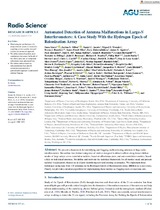| dc.identifier.citation | Storer, D., Dillon, J.S., Jacobs, D.C., Morales, M.F., Hazelton, B.J., Ewall‐Wice, A., Abdurashidova, Z., Aguirre, J.E., Alexander, P., Ali, Z.S. and Balfour, Y., 2022. Automated Detection of Antenna Malfunctions in Large‐N Interferometers: A Case Study With the Hydrogen Epoch of Reionization Array. Radio Science, 57(1), p.e2021RS007376. | |
| dc.description.abstract | We present a framework for identifying and flagging malfunctioning antennas in large radio
interferometers. We outline two distinct categories of metrics designed to detect outliers along known failure
modes of large arrays: cross-correlation metrics, based on all antenna pairs, and auto-correlation metrics, based
solely on individual antennas. We define and motivate the statistical framework for all metrics used, and present
tailored visualizations that aid us in clearly identifying new and existing systematics. We implement these
techniques using data from 105 antennas in the Hydrogen Epoch of Reionization Array (HERA) as a case study.
Finally, we provide a detailed algorithm for implementing these metrics as flagging tools on real data sets. | en_US |

